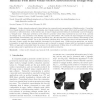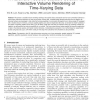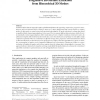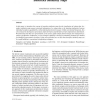121
click to vote
TVCG
2011
14 years 7 months ago
2011
— The growing sizes of volumetric data sets pose a great challenge for interactive visualization. In this paper, we present a feature-preserving data reduction and focus+context ...
TVCG
2011
14 years 7 months ago
2011
—This paper presents a study of gradient estimation methods for rendering unstructured-mesh volume data. Gradient estimation is necessary for rendering shaded isosurfaces and spe...
146
click to vote
JCST
2010
14 years 11 months ago
2010
Surface triangle meshes and volume data are two commonly used representations of digital geometry. Converting from triangle meshes to volume data is challenging, since triangle mes...
111
click to vote
TVCG
2002
15 years 5 days ago
2002
We present a scalable volume rendering technique that exploits lossy compression and low-cost commodity hardware to permit highly interactive exploration of time-varying scalar vol...
111
click to vote
TVCG
1998
15 years 6 days ago
1998
—Volume navigation is the interactive exploration of volume data sets by “flying” the viewpoint through the data, producing a volume rendered view at each frame. We present a...
126
click to vote
CGF
1998
15 years 8 days ago
1998
A multiresolution data decomposition offers a fundamental framework supporting compression, progressive transmission, and level-of-detail (LOD) control for large two or three dime...
101
click to vote
CG
2008
Springer
15 years 20 days ago
2008
Springer
Many volume data possess symmetric features that can be clearly observed, for example, those existing in diffusion tensor image data sets. The exploitations of symmetries for volu...
CGF
2010
15 years 20 days ago
2010
In this paper, we introduce the concept of isosurface similarity maps for the visualization of volume data. Isosurface similarity maps present structural information of a volume d...
106
click to vote
WSCG
2000
15 years 1 months ago
2000
Techniques for simultaneous display of volume data and geometric models have been reported in the literature. These techniques either require conversion from one representation to...
126
Voted
VMV
2003
15 years 1 months ago
2003
In this paper, a simple and efficient solution for combining shear-warp volume rendering and the hardware graphics pipeline is presented. The approach applies an inverse warp tra...




